China Merchants Port Group Bundle
Can CMPort Continue to Dominate the Global Port Industry?
China Merchants Port Group (CMPort) has evolved from a facilitator of trade to a global powerhouse, managing a vast network of ports across continents. With a history deeply intertwined with China's economic rise, CMPort's strategic vision has consistently focused on expanding its footprint and enhancing operational efficiency. As global trade dynamics shift and technological advancements reshape the maritime industry, understanding CMPort's China Merchants Port Group SWOT Analysis is crucial.
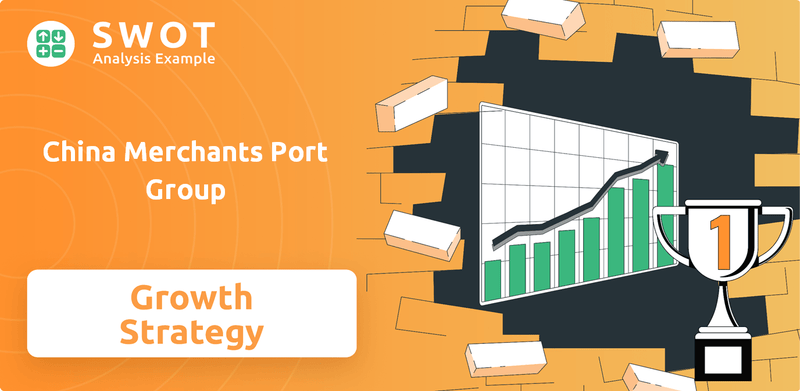
This analysis explores CMPort's journey, from its initial focus on Chinese ports to its current status as a major player in the maritime industry, operating in 26 countries. The company's future hinges on its ability to adapt to evolving global trade patterns, navigate geopolitical complexities, and leverage innovation for sustained port development. Examining CMPort's growth strategy provides valuable insights into the future of global trade and the strategic importance of Chinese ports.
How Is China Merchants Port Group Expanding Its Reach?
China Merchants Port Group (CMPort) is actively pursuing an ambitious expansion strategy focused on both geographical diversification and service enhancements. The company is strategically increasing its global footprint and broadening its service offerings to capitalize on emerging market opportunities and strengthen its position in the maritime industry. This expansion is critical for sustaining long-term growth and adapting to the evolving demands of the global trade landscape.
A key element of CMPort's expansion involves strategic acquisitions and investments in key regions. This approach is designed to enhance its port network and provide comprehensive services to its customers. CMPort's strategy also includes optimizing its existing port operations and developing new services to improve efficiency and increase revenue streams. These initiatives are supported by strategic partnerships and a focus on sustainability and digital transformation.
CMPort's expansion strategy is closely aligned with China's broader economic objectives, including the Belt and Road Initiative. The company's investments in overseas ports and infrastructure projects support China's trade and investment goals, contributing to the country's economic growth and global influence. CMPort's expansion efforts are also shaped by market dynamics, including the evolving needs of its customers and the competitive landscape of the maritime industry.
CMPort's expansion includes strategic acquisitions and investments to broaden its global presence. A significant move was the acquisition of a 51% equity interest in NPH in Indonesia in June 2024, marking a major entry into the Indonesian market. This expansion is designed to leverage Indonesia's economic potential and strengthen its presence in Southeast Asia.
CMPort is actively optimizing its global port network. The company is exploring opportunities for global port resource integration. Existing overseas projects, such as CICT in Sri Lanka, TCP in Brazil, and LCT in Togo, have shown positive developments and increased business volumes. This optimization aims to improve efficiency and increase cargo handling capacity.
CMPort is diversifying its revenue streams by developing port-related services. This includes warehousing, transportation, and logistics. The company is exploring innovative park business models to provide value-added services in bonded port zones. This diversification strategy aims to increase profitability and resilience.
CMPort focuses on building strategic partnerships to enhance its expansion efforts. In November 2024, CMPort signed a letter of intent with Portos do Paraná in Brazil. This agreement outlines mutual goals for promoting joint ventures and enhancing commercial collaboration. Potential concessions and auction opportunities are anticipated by the end of 2025.
CMPort's expansion strategy includes significant investments in existing and new port facilities. For example, TCP in Brazil handled over 1.25 million TEU in 2023. The company invested R$370 million (US$64.5 million) in facility upgrades, including purchasing 11 RTGs and 10 terminal tractors. These investments are critical for increasing cargo handling capacity and operational efficiency.
- Acquisition of NPH in Indonesia to expand its Southeast Asian footprint.
- Optimization of the global port network, including CICT, TCP, and LCT.
- Diversification into port-related services such as warehousing and logistics.
- Strategic partnerships, including a letter of intent with Portos do Paraná.
China Merchants Port Group SWOT Analysis
- Complete SWOT Breakdown
- Fully Customizable
- Editable in Excel & Word
- Professional Formatting
- Investor-Ready Format
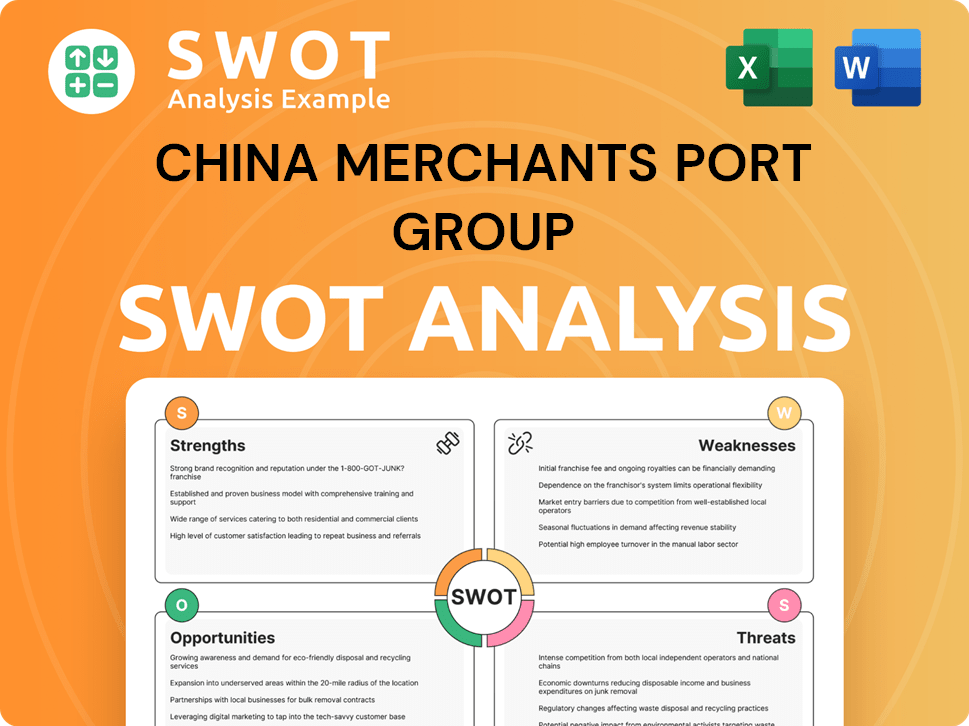
How Does China Merchants Port Group Invest in Innovation?
China Merchants Port Group (CMPort) is heavily invested in leveraging technology and innovation to drive sustained port growth. The company focuses on developing a smart and diversified port ecosystem. This approach is central to its long-term strategy, aiming to enhance operational efficiency and sustainability within the maritime industry.
CMPort emphasizes the critical role of scientific and technological innovation in building an independent and controllable terminal operating system. This strategy involves the promotion of 'digital intelligence' and 'green' upgrades across its operations. By integrating advanced technologies such as big data, the Internet of Things (IoT), and artificial intelligence, CMPort aims to empower its core business functions, including production, management, services, and port ecology.
The digital transformation is supported by the Smart Management Platform (SMP), a one-stop integrated management platform. This platform supports business analysis across various segments, including container, bulk cargo, logistics parks, comprehensive development, and smart technology. Furthermore, CMPort is actively pursuing green port initiatives, with significant advancements in green port construction and digital product development.
CMPort's digital transformation strategy is centered around the Smart Management Platform (SMP). This platform provides a comprehensive view of operations, supporting data-driven decision-making across various business units. The SMP enhances efficiency and supports strategic planning in areas such as container handling and logistics.
CMPort is committed to sustainability, focusing on green port initiatives to reduce its environmental impact. These efforts include the electrification of equipment and the installation of renewable energy sources. Such initiatives are key to enhancing CMPort's contribution to environmental protection within the maritime industry.
CMPort utilizes next-generation information technology, including big data, IoT, and AI, to improve its operations. These technologies enhance efficiency, optimize resource allocation, and provide better services. The integration of advanced technologies supports CMPort's goal of becoming a smart port operator.
CMPort's technology strategy aims to improve operational efficiency across all aspects of its business. This includes faster cargo handling, better resource management, and improved customer service. These enhancements contribute to CMPort's competitive advantage in the port development sector.
CMPort is expanding its global presence through strategic partnerships and technology deployments. This expansion includes the implementation of its container terminal operating system (CTOS) in various international locations. These initiatives support CMPort's growth and enhance its global competitiveness.
CMPort collaborates with various partners to enhance its technological capabilities and expand its market reach. These partnerships help CMPort to leverage expertise and resources, supporting its growth strategy. Strategic alliances are crucial to CMPort's success in the competitive maritime industry.
In the first half of 2024, CICT completed the electrification of 54 trailers and added 175 new electric trailers in the West Shenzhen Port Zone, along with the implementation of new photovoltaic installations. CMPort's subsidiary, China Merchants International Technology (CMIT), entered into a cooperation agreement for its container terminal operating system (CTOS) with Mediterranean Intermodal Terminal Operator in Italy in September 2024, marking its second such project in Europe. These initiatives showcase CMPort's commitment to technological advancement and sustainability.
- The Smart Management Platform (SMP) is utilized for integrated management across various segments, enhancing operational efficiency.
- Green port initiatives include the electrification of equipment and the implementation of renewable energy.
- CMIT's CTOS is being deployed internationally, expanding CMPort's global footprint.
- Strategic partnerships support CMPort's technological capabilities and market reach.
- CMPort's focus on technology and innovation aligns with its broader marketing strategy.
China Merchants Port Group PESTLE Analysis
- Covers All 6 PESTLE Categories
- No Research Needed – Save Hours of Work
- Built by Experts, Trusted by Consultants
- Instant Download, Ready to Use
- 100% Editable, Fully Customizable
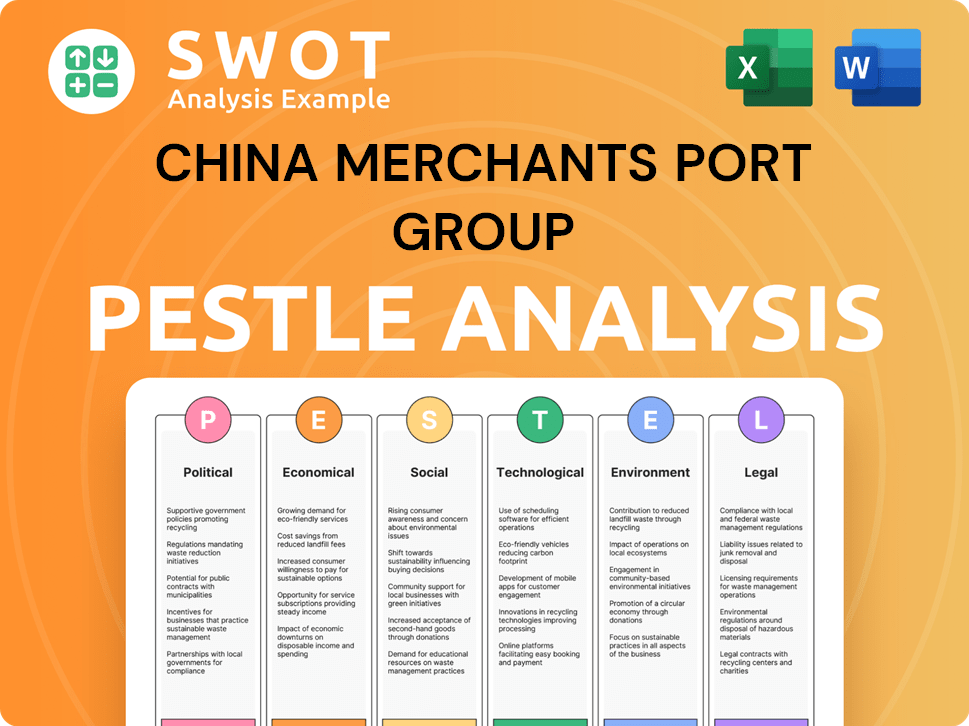
What Is China Merchants Port Group’s Growth Forecast?
In 2024, China Merchants Port (CMPort) demonstrated strong financial results. The company's operating income reached RMB16,131 million, marking a 2.41% year-on-year increase. Net profit attributable to shareholders of the listed company rose significantly, reaching RMB4,516 million, a substantial 26.44% increase compared to the previous year.
The consolidated results for CMPort show that profit attributable to equity holders increased by 27.0%, totaling HK$7,919 million. This growth was supported by a notable rise in recurrent profit from port operations. Basic earnings per share also saw a positive trend, increasing by 23.1% during the same period. These figures reflect the company's solid financial health and operational efficiency.
CMPort's commitment to shareholder value is evident in its dividend policy. A final dividend of HKD 0.636 per share was declared for the year ended December 31, 2024, with payment scheduled for July 10, 2025. This demonstrates the company's ability to generate and distribute profits, reinforcing investor confidence.
Container throughput at CMPort increased by 6.0% in 2024, indicating strong performance in handling containerized cargo. Bulk cargo throughput also saw growth, with a 0.3% increase, reflecting the company's diversified cargo handling capabilities. These figures highlight CMPort's ability to manage and grow its cargo volumes effectively.
The West Shenzhen Port Zone achieved a record high container throughput, exceeding 15 million TEUs. This significant achievement underscores the zone's efficiency and importance in the port network. Furthermore, its market share of foreign trade containers in Shenzhen Port exceeded 50%, solidifying its leading position.
CMPort's investment strategy focuses on hub ports located in regions with strong economic growth potential. The company aims to provide efficient port logistics services, which enhances value creation for its stakeholders. This strategic approach supports long-term sustainable growth and profitability.
Despite global economic pressures in 2024, the port industry is expected to evolve steadily. CMPort plans to continue its high-quality development in 2025, driven by its core strategies. These strategies include 'Global Presence,' 'Lean Management,' and 'Innovative Transformation,' which are designed to drive future growth.
China Merchants Port Group Business Model Canvas
- Complete 9-Block Business Model Canvas
- Effortlessly Communicate Your Business Strategy
- Investor-Ready BMC Format
- 100% Editable and Customizable
- Clear and Structured Layout
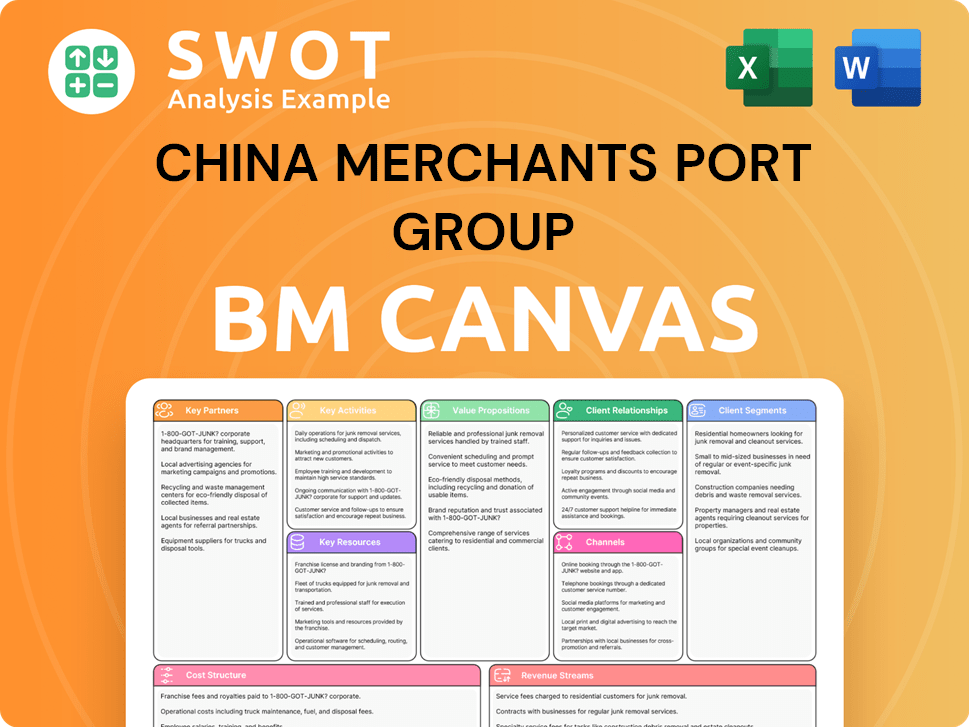
What Risks Could Slow China Merchants Port Group’s Growth?
China Merchants Port faces several risks that could affect its growth strategy. These challenges include a complex global environment, policy changes, and operational difficulties. Understanding these risks is crucial for evaluating the company's long-term prospects and investment potential.
Geopolitical tensions, rising trade protectionism, and global debt levels create uncertainties for CMPort. These external factors can significantly impact trade volumes and port operations. Additionally, internal structural contradictions within the company and fluctuations in exchange rates pose further challenges.
The company also faces risks from policy changes, such as alterations in tariffs and port investment regulations. These factors can create instability and affect the company's financial performance. Furthermore, supply chain vulnerabilities and increased market competition are ongoing challenges in the maritime industry.
Intensifying geopolitical situations and rising trade protectionism can disrupt global trade flows. Increased global debt also presents challenges to stable economic growth. These factors can directly affect CMPort's operational environment and financial results.
Changes in regulations concerning tariffs, port investment, and operations can introduce uncertainties. These policy shifts can impact CMPort's strategic planning and investment decisions. The company must adapt to these evolving regulatory landscapes.
Fluctuations in international exchange rates, particularly the strength of the US dollar and currency depreciation risks in emerging economies, can create operational difficulties, especially for overseas investments. Supply chain vulnerabilities and heightened market competition also pose ongoing challenges. For a deeper understanding of the competitive environment, you can explore the Competitors Landscape of China Merchants Port Group.
The port industry is highly competitive. Increased competition from other ports and logistics providers can affect CMPort's market share and profitability. CMPort must continuously innovate and improve its services to maintain its competitive edge.
Disruptions in the global supply chain, such as those caused by geopolitical events or natural disasters, can impact port operations. These vulnerabilities can lead to delays, increased costs, and reduced efficiency. CMPort needs to develop strategies to mitigate these risks.
Environmental, social, and governance (ESG) risks are becoming increasingly important. CMPort must manage its environmental impact, ensure fair labor practices, and maintain strong corporate governance. Failure to address these risks can harm the company's reputation and financial performance.
CMPort actively mitigates these risks through several strategies. The company strengthens policy research to anticipate regulatory changes. It enhances operational efficiency and rationalizes resource allocation. Furthermore, CMPort focuses on technological innovation and industry digitization to improve its operational management.
CMPort has a comprehensive sustainable development management system, including an ESG risk management framework. This framework helps the company assess and prepare for risks related to environmental, social, and governance factors. In the first half of 2024, the company continued to implement its COE plan to optimize its lean operation value tree model.
China Merchants Port Group Porter's Five Forces Analysis
- Covers All 5 Competitive Forces in Detail
- Structured for Consultants, Students, and Founders
- 100% Editable in Microsoft Word & Excel
- Instant Digital Download – Use Immediately
- Compatible with Mac & PC – Fully Unlocked
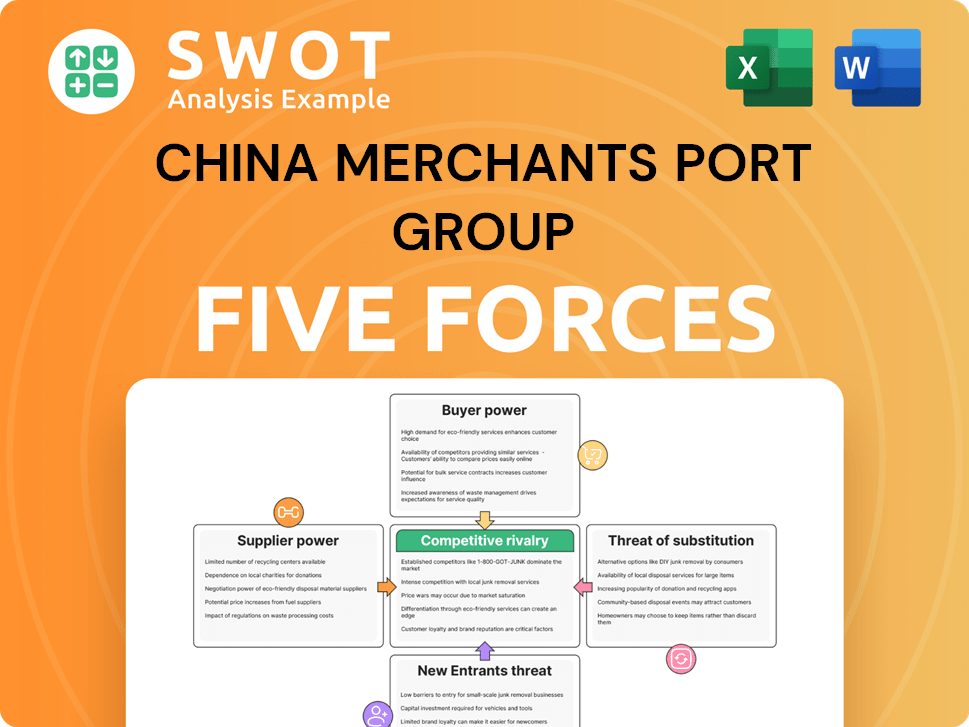
Related Blogs
- What are Mission Vision & Core Values of China Merchants Port Group Company?
- What is Competitive Landscape of China Merchants Port Group Company?
- How Does China Merchants Port Group Company Work?
- What is Sales and Marketing Strategy of China Merchants Port Group Company?
- What is Brief History of China Merchants Port Group Company?
- Who Owns China Merchants Port Group Company?
- What is Customer Demographics and Target Market of China Merchants Port Group Company?
Disclaimer
All information, articles, and product details provided on this website are for general informational and educational purposes only. We do not claim any ownership over, nor do we intend to infringe upon, any trademarks, copyrights, logos, brand names, or other intellectual property mentioned or depicted on this site. Such intellectual property remains the property of its respective owners, and any references here are made solely for identification or informational purposes, without implying any affiliation, endorsement, or partnership.
We make no representations or warranties, express or implied, regarding the accuracy, completeness, or suitability of any content or products presented. Nothing on this website should be construed as legal, tax, investment, financial, medical, or other professional advice. In addition, no part of this site—including articles or product references—constitutes a solicitation, recommendation, endorsement, advertisement, or offer to buy or sell any securities, franchises, or other financial instruments, particularly in jurisdictions where such activity would be unlawful.
All content is of a general nature and may not address the specific circumstances of any individual or entity. It is not a substitute for professional advice or services. Any actions you take based on the information provided here are strictly at your own risk. You accept full responsibility for any decisions or outcomes arising from your use of this website and agree to release us from any liability in connection with your use of, or reliance upon, the content or products found herein.